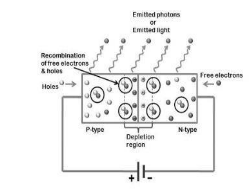In electrical engineering, a light-emitting diode (LED) is a semiconductor device that emits light when an electric current passes through it. When current flows through an LED, the electrons recombine with the holes in the device, resulting in the emission of light. A LED is a device that allows current to flow in one direction but prevents current from flowing in the other direction.
P-n junctions, which are used in light-emitting diodes, are severely doped. When forward biassed, an LED will emit a coloured light at a specific spectral wavelength that is dependent on the semiconductor material used and the quantity of doping added to the LED. As depicted in the illustration, an LED is enclosed with a transparent cover to allow the emitted light to be seen.
Working of LED
When the LED diode is forward biassed, it functions in the same way as an ordinary diode. In this situation, the n-type semiconductor is more severely doped than the p-type semiconductor, resulting in the formation of a p-n junction. Light or photons are released or radiated in all directions when the device is forward biassed because the potential barrier is reduced and the electrons and holes mix at the depletion layer (or active layer) when the device is forward biassed. An example figure demonstrating light emission due to electron-hole pair combining on forward biassing is shown in the following figure.

The energy band theory of solids provides the rationale for the emission of photons by an LED diode and can be used to explain the phenomenon. According to this theory, whether or not the electron-hole combination results in the emission of photons is dependent on whether or not the material has a direct band gap or an indirect band gap. Photons are emitted by semiconductor materials that have a direct band gap, as opposed to indirect band gaps. A direct bandgap material is one in which the bottom of the conduction band’s energy level is located exactly above the top of the valence band’s energy level on the Energy vs Momentum (wave vector “k”) diagram, and vice versa. Light or photons are released as a result of the reaction between electrons and holes, resulting in an escape of energy equal to E = hv, where E = hv is the energy gap (eV) and h is the Planck’s constant and f is the frequency of light.

Physical Structure of LED
The LED is constructed in such a way that the light emitted does not re-enter the substance into which it was originally emitted. Because of this, it is guaranteed that the electron-hole recombination will occur on the surface.
The two alternative techniques of structuring an LED p-n junction are depicted in the figure above. The p-type layer is grown on the n-type substrate after it has been thinned off. A pair of metal electrodes connected on either side of the p-n junction serve as nodes for connecting to the outside world electrically. The light-emitting diode p-n junction is housed in a transparent dome-shaped housing to ensure that light is emitted uniformly in all directions and that internal reflection is kept to a very bare minimum.
The positive electrode, often known as the anode, is represented by the longer leg of the LED.
LEDs with more than two legs, such as three, four, and six pin layouts, are also available, allowing you to get many colours from a single LED package. Surface-mounted LED displays are available that can be placed directly on printed circuit boards (PCBs). LEDs have a current rating of a few tens of milliamps or less. A strong resistance must be connected in series with it in order to prevent this. The forward voltage drop of an LED is significantly greater than that of a conventional diode, ranging from 1.5 to 3.5 volts.
Advantages of LED
The amount of light radiated by an LED is determined by the amount of current flowing through the LED device. Since the current can be easily regulated, it is possible to control the brightness of an LED with ease. This makes it possible to operate LED displays in a variety of illumination environments:
- Light-emitting diodes (LEDs) have a low energy consumption.
- LEDs are quite inexpensive and widely available.
- LEDs are extremely lightweight.
- Smaller size.
- LEDs have a longer useful life.
- LEDs are extremely rapid in their operation. They may be turned on and off in a very short period of time if necessary.
- As opposed to fluorescent bulbs, which contain harmful materials such as mercury, LEDs do not contain such substances.
- LEDs are capable of emitting light in a variety of hues.
- LEDs have a low efficiency in terms of light output.
The following are some of the different LED applications
- Burglar alarm systems are used to deter intruders.
- Calculators
- Phones that take pictures
- Traffic signals are used to direct traffic.
- Computers that are digital
- Multimeters
- Microprocessors
- Watches with digital displays
- Heat lights for automobiles
- The flash of the camera is heard.
- Lighting for the aviation industry
Conclusion
LEDs have a wide range of applications in a variety of industries, including optical communication, alarm and security systems, remote-controlled operations, robotics, and other similar fields. It finds application in a wide range of fields due to its long-lasting capability, low power consumption, quick response time, and fast switching capabilities, among other factors. LEDs consume less power and require a lower operating voltage than other lighting technologies. LEDs require no warm-up time before they can be used.
 Profile
Profile Settings
Settings Refer your friends
Refer your friends Sign out
Sign out




